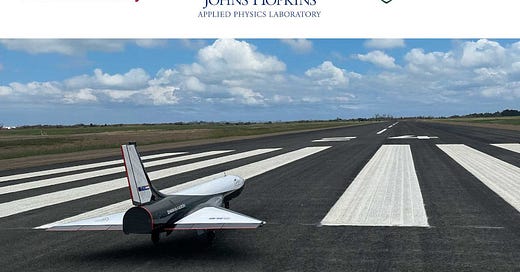Top U.S. Universities Ink Deals for Suborbital Research
Will Utilize the Dawn Aerospace Mk-II Aurora Vehicle
Research payloads from three leading U.S. institutions, Arizona State University, California Polytechnic State University, and Johns Hopkins Applied Physics Lab, will fly on the Dawn Aerospace Mk-II Aurora rocket-powered aircraft.
"This initiative highlights New Zealand as a world leader in research and development of aerospace technology."
Stefan Powell, Dawn Aerospace
The flights, scheduled for April and June 2025, will showcase the Mk-II Aurora's capabilities as a reusable, high-cadence suborbital vehicle. Dawn Aerospace will also fly payloads for Scout Space, a US based commercial customer during the same campaign.
These missions will take place from the Tāwhaki National Aerospace Centre at Kaitorete, just outside Christchurch, as Dawn’s first commercial flights since runway facilities were established in 2024.
The three Pathfinder flights will support ground-breaking research in their respective fields:
Arizona State University: a leader in space science and engineering, will fly a modified version of its THEMIS visual imaging system (LEO-TIMS).
California Polytechnic State University: well known for its CubeSat program and aerospace engineering, will test a student-developed flight path reconstruction data acquisition system to collect GPS and air data in calibration with the Mk-II’s systems.
Johns Hopkins Applied Physics Laboratory: a leading research and development institution that has designed and built spacecraft and specialized instruments that have visited the Sun and every planet in the solar system; will fly a payload interface system known as JANUS-Lite that measures the Aurora's payload bay environment, collecting data on magnetic field, acceleration, pressure, and thermal conditions.
“The Mk-II Aurora presents a rapidly reusable space capability, with the power to unlock new economic, environmental, and scientific value.” said Stefan Powell, CEO. “This initiative highlights New Zealand as a world leader in research and development of aerospace technology, planting the seed that will grow into ongoing international collaboration and expansion for many years to come.”
The three flights are supported by the Ministry of Business, Innovation and Employment (MBIE) on behalf of the New Zealand Government.
The vehicle used for the pathfinder flights is the “Mk-IIA”, which in November 2024, was the first civil aircraft to break the sound barrier since the Concorde, as well as breaking world climb rate records and reaching 25km (≈ 16 miles) in altitude.
The next generation vehicle, the Mk-IIB, will be the highest and fastest flying vehicle ever to take off from a runway, reaching Mach 3.5 and an altitude of 100km (≈ 61 miles).





